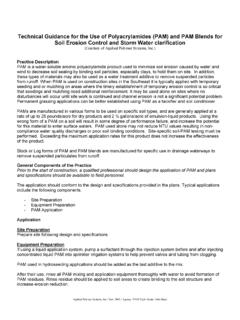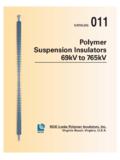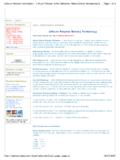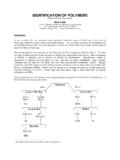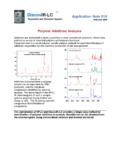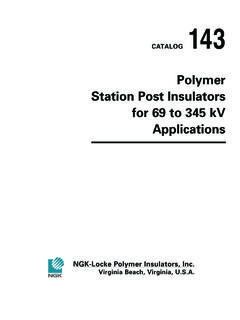Transcription of Stormwater Best Management Practice: Polymer Flocculation
1 Minimum MeasureConstruction Site Stormwater Runoff ControlSubcategorySediment ControlStormwater Turbidity and Its Aquatic Life ToxicityTurbidity is a measure of the amount of suspended material in a liquid. In Stormwater or a natural waterbody ( , river, lake, or estuary), turbidity depends on the amount of suspended sediment, dissolved organic matter, and plankton in the water. Turbid Stormwater entering a natural waterbody can significantly degrade the habitat of fish and other aquatic life. Reductions in light levels may reduce submerged aquatic vegetation that provides the cover necessary for survival of the prey species. Or reduced visibility may make it difficult for predators to find evasive prey. Gravel on the bottom of a riverbed, which is necessary for salmon to spawn successfully, may be covered with sediments. Often it s not just a few species but the whole food chain that s affected.
2 One of the references on page 7 (Meager, 2013) is an article for non-scientists on how turbidity affects the growth, reproduction, and survival of fish. Another reference (Meager, 2006) lists over 185 technical publications, which thoroughly document the toxic effects of Stormwater turbidity on aquatic instrument used to measure the turbidity of a liquid is called a nephelometer. It works by passing a light beam (source beam) through a sample of the liquid and then measuring the light scattered by the suspended particles with a light detector set to the side (often 90 ) from the source beam. The particle density is a function of the light scattered toward the detector by the suspended particles in the liquid. The units of turbidity measured by a calibrated nephelometer are called Nephelometric Turbidity Units (NTU). Contractors can use a hand-held nephelometer to measure the turbidity of their construction site s Stormwater Flocculation for Reducing Stormwater Turbidity and Its Aquatic Life ToxicityFlocculation is the process where a chemical agent (flocculant) is used to reduce the turbidity of a liquid by binding suspended particles in the liquid together to form larger particles (flocs) that are heavy enough to settle to the bottom of the liquid.
3 When the liquid is Stormwater runoff, this particle binding and settling process reduces soil erosion and the runoff s turbidity, as well as the aquatic life toxicity associated with turbidity. Some polymers are good flocculants. Polymers are chemical compounds that have very large molecules composed of one or more structural units that are joined together in a repeating pattern to form long chain-like macromolecules. The two red wavy ribbons in Figure 1 represent Polymer molecules ++-Soil+-++-+++---+Soil--++-SoilCationic Polymer Chains---SoilSoil+-+Ion BridgeFigure 1. Cationic Polymer flocculationdissolved in water, and the brown circles represent suspended soil particles. Cationic Polymer molecules have positive charges, and many soil particles (particularly clays) have negative charges. The negatively charged soil particles are attracted to the positively charged Polymer molecules, and this causes the soil particles to bind with the Polymer chains as shown in Figure 1.
4 Many of the soil particles form ionic bridges between the Polymer chains, and some bind to the outside of the Polymer chains. This binding process continues until many thousands of Polymer chains and soil particles combine to form a floc having sufficient mass to settle to the bottom, thereby reducing the water s cationic polymers are effective flocculants and do reduce turbidity, their positive charges make them toxic to aquatic organisms when dissolved in water. Consequently they should not be used as flocculants in Stormwater that runs off Office of Water, 2013 Stormwater best Management PracticePolymer Flocculation Stormwater best Management Practice: Polymer Flocculationthe land into natural waterbodies. However, anionic polymers, which carry a negative charge, are not toxic. If they re added to Stormwater along with some positive ions, the soil particles will bind onto these anionic Polymer molecules and form the ionic bridges shown in Figure 2.
5 Adding positive calcium ions (Ca++) to the anionic Polymer enables anionic Polymer Flocculation , which can reduce the turbidity without harming the aquatic collection becomes important if the Stormwater runoff velocity is too high to allow the flocs to settle to the bottom. In these cases an attachment surface, such as the soft matting (jute, hemp, burlap, or coconut coir) shown in Figure 3, needs to be installed across the flow to collect the flocs. Polymer Flocculation is based on three fundamental processes: chemical binding, settling, and floc Flocculation BMPsPolymer Flocculation provides the basis for a number of best Management practices (BMPs) for reducing Stormwater turbidity and its toxicity. Flocculants can be applied directly to: the soil surface, water flowing in a channel, a natural waterbody, or a settling pond.
6 Examples of these four basic types of BMP applications are described below. One of them alone may be sufficient for a relatively simple project, or several of these BMPs may be used together to design a Polymer Flocculation system for a larger Surface Applications 3 examplesSoil stabilization. The objective is to bind soil particles together so they become more resistant to the erosive forces of wind or water and to promote revegetation following a soil disturbing activity such as construction. Soft matting can be applied over the ground (Figure 4) to provide an attachment surface for floc collection as runoff flows down the slope. If hydroseeding is used, the addition of a Polymer flocculant in liquid form to the hydroseeding mix will bind the seed, fertilizer, and other additives to the soil until the new vegetation is established.
7 The hydroseeding mix is then sprayed on the slope (Figure 5), and vegetation is established to stabilize the slope (Figure 6). When hydroseeding is not used, the powdered Polymer can be applied by hand over the matting. When it rains, the powdered Polymer dissolves and the soil particles become chemically bound to the long Polymer molecules. The resulting flocs are sticky and adhere to the fibers of the soft matting to create a highly erosion resistant surface that supports vegetation. If straw or mulch is used instead of soft matting to cover the ground, the flocs will also adhere to either of them and provide good erosion resistance and revegetation support. Dispersion fields. The objective is to reduce the velocity, erosive force, and turbidity of rapidly flowing water by allowing it to spread out over a relatively level area.
8 Checks or wattles can be placed perpendicular to the flow to reduce its velocity. Soft matting installed over the dispersion field and covered with a Polymer powder will reduce the water s turbidity by binding the suspended particles together so they form particulate- Polymer agglomerations that settle and adhere to the jute matting. When wells are drilled during home construction to provide drinking water or geothermal water for heating and air ------SoilSoilAnionic Polymer ChainsIonic BridgeSoilSoil--Ca++Ca++-Ca++Ca++-Ca++Ca ++-Ca++Ca++-Ca++Ca++-Ca++Ca++---Soil--Ca ++Ca++-Ca++Ca++------Ca++Ca++-Ca++Ca++-C a++Ca++-Ca++Ca++Ca++Ca++Ca++Ca++Ca++Ca++ Positive IonFigure 2. Anionic Polymer Flocculation Figure 3. Matting used for floc collection Figure 4. Slope covered with floc collection mattingFigure 5. Hydroseeding the slopeFigure 6.
9 Stabilization four weeks laterStormwater best Management Practice: Polymer Flocculation3conditioning systems, the water discharged from the drilling operations can be laden with rock chips and sediment and is often toxic. A drilling rig and its settling pit that allows larger particles from the rig s discharge to settle out is shown in Figure 7. The water then flows through a Flocculation ditch and a small dispersion field, which is lined with jute matting covered with Polymer flocculant powder to clarify the water before it s discharged. The turbidity of water coming from the drilling rig was over 5,000 NTU. But after the settling pit and Polymer Flocculation in the mixing ditch and dispersion field, the discharged water s turbidity was reduced to 2 much larger dispersion field was needed to clarify the spoils from a dredging operation before they were discharged back into a Tennessee Valley Authority lake.
10 The dredge spoils were initially pumped into a settling pond to allow the heaver particles to settle. Then after passing through the mixing ditch in Figure 8, they entered an 8,100 square foot dispersion field (Figure 9) lined with jute matting, which was covered with a powdered Polymer flocculant. After passing over a dispersion field and through a sediment retention barrier, the clarified water was returned to Kentucky Lake (Figure 10). The dredge spoils pumped into the settling pond were 15% solids. After settling, the water discharged from the settling pond had a turbidity ranging from 500 to 600 NTUs. And after Flocculation in the treatment ditch followed by additional Flocculation and particle collection in the dispersion field and a sediment retention barrier, the turbidity was only 21 control. The objective of dust control is to reduce airborne dust from haul roads, tailings piles, waste dumps, and open areas on construction sites.
